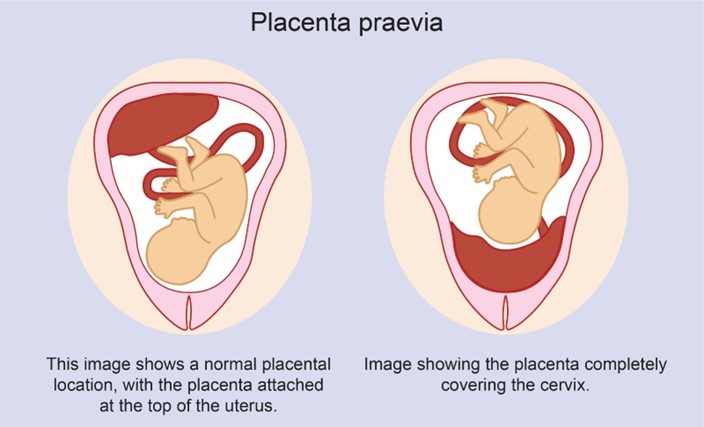At 22 weeks' gestation, a client is diagnosed with placenta previa. The doctor tells the client that the placenta may move away from the cervix as the pregnancy progresses. This is classified as what type of previa?
Partial.
Complete.
Marginal.
Low-lying.
The Correct Answer is D
Choice A Reason: Partial placenta previa is a condition where the placenta partially covers the cervix. It usually does not resolve and may cause bleeding and complications during labor and delivery.
Choice B Reason: Complete placenta previa is a condition where the placenta completely covers the cervix. It is a serious condition that requires cesarean delivery and may cause life-threatening hemorrhage.
Choice C Reason: Marginal placenta previa is a condition where the edge of the placenta reaches the margin of the cervix. It may also cause bleeding and complications during labor and delivery.
Choice D Reason: Low-lying placenta previa is a condition where the placenta is near the cervix, but not covering it. It may resolve spontaneously as the uterus grows and the placenta moves upward.

Nursing Test Bank
Naxlex Comprehensive Predictor Exams
Related Questions
Correct Answer is C
Explanation
Choice A Reason: Macrosomic newborn. This is a correct answer that describes a possible complication of post-term pregnancy. A macrosomic newborn is a newborn that weighs more than 4000 grams or 8 pounds 13 ounces at birth. It can occur in post-term pregnancies due to prolonged exposure to maternal glucose and insulin. It can increase the risk of birth injuries, shoulder dystocia, cesarean delivery, and hypoglycemia.
Choice B Reason: Intrauterine growth restriction (IUGR). This is a correct answer that indicates a potential problem of post-term pregnancy. IUGR is a condition where the fetal growth is slower than expected for gestational age. It can occur in post-term pregnancies due to placental insufficiency, aging, or calcification, which can impair nutrient and oxygen delivery to the fetus. It can increase the risk of fetal distress, hypoxia, acidosis, and stillbirth.
Choice C Reason: Umbilical cord prolapse. This is an incorrect answer that does not reflect a risk of post-term pregnancy, but rather a risk of other factors such as prematurity, low birth weight, breech presentation, multiple gestation, polyhydramnios, or artificial rupture of membranes.
Choice D Reason: Meconium Aspiration Syndrome (MAS). This is a correct answer that denotes a possible complication of post-term pregnancy. MAS occurs when fetal stool (meconium) enters into the lungs before or during birth, causing airway obstruction, inflammation, and infection. MAS usually affects term or post-term infants who experience fetal distress or hypoxia in utero. It can cause respiratory distress syndrome (RDS), persistent pulmonary hypertension (PPHN), or chronic lung disease (CLD).
Correct Answer is D
Explanation
Choice A Reason: "My baby will always be smaller than other babies his age." This is an incorrect answer that indicates a misconception or pessimism about SGA newborns. SGA newborns may not always be smaller than other babies their age, as they may catch up in growth and development with appropriate nutrition and care. SGA newborns may have different growth paterns depending on the cause and timing of their growth restriction.
Choice B Reason: "My baby will be okay as long as he has frequent feedings." This is an incorrect answer that indicates an oversimplification or optimism about SGA newborns. SGA newborns may not be okay with just frequent feedings, as they may have other problems or complications that require medical atention and intervention. SGA newborns may have increased nutritional needs and feeding difficulties due to low birth weight, poor suck-swallow coordination, or oral aversion.
Choice C Reason: "My baby will need to stay in the hospital until he weighs 5 pounds." This is an incorrect answer that indicates a misunderstanding or confusion about SGA newborns. SGA newborns may not need to stay in the hospital until they weigh 5 pounds, as they may be discharged earlier or later depending on their condition and readiness for home care. SGA newborns may have different criteria for discharge based on their gestational age, weight gain, feeding tolerance, temperature stability, and absence of complications.
Choice D Reason: "My baby can get cold easily, may have low blood sugar, and may have trouble breathing." This is because this statement by the parents indicates that they understand some of the common problems and complications that SGA newborns may face. SGA newborns are those who weigh less than the 10th percentile for their gestational age, which can be due to intrauterine growth restriction (IUGR) or constitutional factors. SGA newborns may have difficulties with thermoregulation, glucose metabolism, and respiratory function due to inadequate fat stores, glycogen reserves, and surfactant production.
Whether you are a student looking to ace your exams or a practicing nurse seeking to enhance your expertise , our nursing education contents will empower you with the confidence and competence to make a difference in the lives of patients and become a respected leader in the healthcare field.
Visit Naxlex, invest in your future and unlock endless possibilities with our unparalleled nursing education contents today
Report Wrong Answer on the Current Question
Do you disagree with the answer? If yes, what is your expected answer? Explain.
Kindly be descriptive with the issue you are facing.
